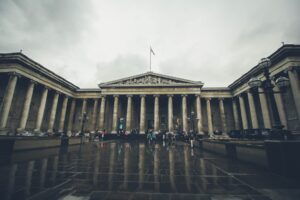Korean fashion has gained significant attention and popularity in recent years, thanks to the global influence of K-pop and Korean dramas. The fashion scene in South Korea is known for its unique blend of traditional elements and modern trends, creating a distinct and innovative style that has captivated fashion enthusiasts around the world. Korean fashion is characterized by its emphasis on clean lines, minimalistic designs, and a focus on quality fabrics and craftsmanship. The fashion industry in South Korea has experienced rapid growth and has become a major player in the global fashion market, with Korean designers and brands gaining recognition and acclaim on an international scale.
Korean fashion is not just about clothing; it is a reflection of the country’s rich cultural heritage and its dynamic and evolving society. From traditional hanbok to cutting-edge street style, Korean fashion encompasses a wide range of influences and inspirations, making it a fascinating and diverse world to explore. Whether you’re drawn to the elegance of hanbok or the edginess of K-pop-inspired looks, Korean fashion offers something for everyone, making it a vibrant and exciting part of the global fashion landscape.
Key Takeaways
- Korean fashion is known for its unique blend of traditional and modern styles, influenced by K-pop and street fashion.
- The hanbok is the traditional Korean outfit, characterized by vibrant colors and graceful lines, and is often worn during special occasions and celebrations.
- Modern Korean fashion trends include a mix of minimalism, oversized silhouettes, and bold patterns, reflecting the country’s dynamic and innovative fashion scene.
- K-pop has had a significant impact on Korean fashion, with K-pop idols and groups often setting trends and influencing the global fashion industry.
- Korean street style is characterized by its eclectic and edgy aesthetic, with a focus on mixing and matching different styles and incorporating unique accessories.
Traditional Korean Outfits: Hanbok
Hanbok, the traditional Korean attire, holds a special place in Korean culture and history. The hanbok is characterized by its graceful lines, vibrant colors, and intricate embroidery, reflecting the elegance and beauty of Korean aesthetics. The hanbok consists of a jeogori (jacket) and chima (skirt) for women, and a jeogori and baji (pants) for men. The garments are often made from luxurious silk or satin fabrics and are adorned with delicate floral patterns or geometric designs. Hanbok is typically worn during traditional ceremonies and celebrations, such as weddings, birthdays, and holidays, and is a symbol of Korean cultural identity and pride.
In recent years, there has been a resurgence of interest in hanbok, with modern interpretations of the traditional attire gaining popularity in the fashion world. Contemporary hanbok designs often feature updated silhouettes, experimental color combinations, and innovative styling, appealing to a younger generation while still honoring the timeless beauty of the hanbok. The revival of hanbok in modern fashion reflects a renewed appreciation for Korean heritage and craftsmanship, as well as a desire to preserve and celebrate the country’s cultural traditions in a contemporary context.
Modern Korean Fashion Trends
Modern Korean fashion is known for its cutting-edge designs, innovative silhouettes, and avant-garde aesthetics. Korean designers are celebrated for their ability to push boundaries and challenge conventional norms, creating fashion that is both daring and sophisticated. One of the key trends in modern Korean fashion is the emphasis on gender-neutral clothing, with many designers blurring the lines between traditional menswear and womenswear to create unisex pieces that defy categorization. This inclusive approach to fashion reflects the progressive mindset of Korean society and its openness to diversity and individual expression.
Another prominent trend in Korean fashion is the fusion of traditional elements with contemporary styles, resulting in a harmonious blend of old and new. This juxtaposition of classic and modern influences creates a unique and eclectic fashion landscape that sets Korean fashion apart from its counterparts. Additionally, Korean fashion is known for its bold use of color, playful patterns, and unexpected details, adding an element of whimsy and spontaneity to the overall aesthetic. Whether it’s oversized silhouettes, deconstructed tailoring, or experimental layering, Korean fashion continues to push boundaries and redefine the concept of sartorial expression.
Influences of K-pop on Korean Fashion
| Aspect | Impact |
|---|---|
| Trendsetting | K-pop influences fashion trends in Korea and globally. |
| Brand collaborations | K-pop idols often collaborate with fashion brands, boosting their popularity. |
| Street style | K-pop street style has become a major influence on Korean fashion. |
| Makeup and beauty | K-pop idols’ makeup and beauty looks inspire Korean beauty trends. |
| Gender-neutral fashion | K-pop challenges traditional gender norms, influencing gender-neutral fashion. |
The global phenomenon of K-pop has had a profound impact on Korean fashion, shaping trends and influencing style choices both in South Korea and beyond. K-pop idols are not only known for their musical talents but also for their impeccable sense of style and trendsetting looks. The influence of K-pop on Korean fashion can be seen in the way idols effortlessly mix high-fashion pieces with streetwear, creating bold and dynamic ensembles that resonate with fans worldwide. K-pop has also played a significant role in popularizing Korean street style, with fans emulating their favorite idols’ outfits and creating their own interpretations of K-pop-inspired looks.
K-pop’s impact on Korean fashion extends beyond individual style choices; it has also led to collaborations between K-pop stars and fashion brands, resulting in limited-edition collections and exclusive merchandise that cater to the demands of dedicated fans. Additionally, K-pop music videos often serve as a platform for showcasing cutting-edge fashion and avant-garde styling, further cementing the close relationship between K-pop and Korean fashion. The global reach of K-pop has undoubtedly elevated the visibility of Korean fashion on the world stage, solidifying its position as a major player in the international fashion industry.
Korean Street Style
Korean street style has garnered attention for its eclectic mix of influences, ranging from vintage nostalgia to futuristic minimalism. Seoul, in particular, has emerged as a hub for street style enthusiasts, with its vibrant neighborhoods serving as a backdrop for creative self-expression through fashion. Korean street style is characterized by its fearless approach to mixing patterns, textures, and colors, resulting in eye-catching ensembles that exude confidence and individuality. Street style in South Korea is also known for its emphasis on accessories, with statement earrings, bold sunglasses, and unique handbags playing a pivotal role in completing a look.
The rise of social media has further propelled Korean street style into the spotlight, with platforms like Instagram serving as a showcase for emerging trends and style icons. Influencers and fashion enthusiasts alike have embraced the power of street style as a form of self-expression, using it as a means to communicate their personal narratives and showcase their creativity. From oversized outerwear to quirky layering techniques, Korean street style continues to evolve and captivate audiences with its fearless spirit and unapologetic approach to fashion.
Korean Fashion Designers and Brands

South Korea boasts a thriving community of talented fashion designers who have made significant contributions to the global fashion landscape. From established luxury labels to emerging avant-garde brands, Korean designers have garnered attention for their innovative designs and meticulous attention to detail. Designers such as Juun.J, Wooyoungmi, and Blindness have gained international acclaim for their boundary-pushing collections that challenge traditional notions of beauty and style. These designers are celebrated for their ability to infuse their creations with a sense of artistry and individuality that sets them apart from their counterparts.
In addition to high-end designers, South Korea is also home to a vibrant streetwear scene, with brands like Ader Error, ADER x MAISON KITSUNÉ, and IISE gaining recognition for their urban-inspired collections that blend comfort with cutting-edge design. These brands have successfully carved out a niche within the global streetwear market, appealing to a diverse audience with their fresh perspective on casual dressing. Whether it’s avant-garde couture or urban streetwear, Korean designers and brands continue to push boundaries and redefine the concept of contemporary fashion.
Tips for Incorporating Korean Fashion into Your Wardrobe
Incorporating elements of Korean fashion into your wardrobe can be an exciting way to infuse your personal style with a touch of East Asian flair. One way to embrace Korean fashion is by experimenting with layering techniques, mixing different textures and silhouettes to create visually dynamic outfits that exude an air of effortless cool. Additionally, incorporating statement accessories such as oversized earrings or quirky handbags can add an unexpected twist to your look, drawing inspiration from the bold accessorizing often seen in Korean street style.
Another way to incorporate Korean fashion into your wardrobe is by embracing color and pattern in unexpected ways. Experimenting with vibrant hues and playful prints can add a sense of whimsy and spontaneity to your outfits, reflecting the lighthearted approach often seen in Korean fashion. Additionally, exploring unisex or gender-neutral pieces can offer a fresh perspective on dressing that aligns with the inclusive ethos of modern Korean fashion. Ultimately, incorporating elements of Korean fashion into your wardrobe is about embracing creativity and individuality while paying homage to the rich sartorial heritage of South Korea. Whether it’s through traditional hanbok-inspired silhouettes or contemporary streetwear influences, Korean fashion offers endless possibilities for self-expression and exploration within the realm of personal style.
If you’re interested in learning more about Korean outfits, you should check out this article on gravestomper.com. They have a great selection of traditional and modern Korean clothing, as well as tips on how to style them for different occasions. Whether you’re looking for a hanbok for a special event or just want to incorporate some Korean fashion into your everyday wardrobe, this article has you covered.
FAQs
What are traditional Korean outfits called?
Traditional Korean outfits are called hanbok. Hanbok consists of a jeogori (jacket) and chima (skirt) for women, and a jeogori and baji (pants) for men.
What are the characteristics of hanbok?
Hanbok is known for its vibrant colors, simple lines, and graceful curves. It is often made of silk or satin and features intricate embroidery and patterns.
What occasions are hanbok worn for?
Hanbok is worn for traditional Korean celebrations and ceremonies such as weddings, first birthdays (doljanchi), and ancestral rites (jesa). It is also worn for cultural events and festivals.
Are there modern adaptations of hanbok?
Yes, there are modern adaptations of hanbok that incorporate contemporary designs and fabrics. These modern hanbok are often worn for special events, performances, and fashion shows.
What are some popular accessories worn with hanbok?
Some popular accessories worn with hanbok include norigae (decorative ornaments), binyeo (hairpins), and beoseon (traditional socks). These accessories add to the overall elegance of the outfit.


